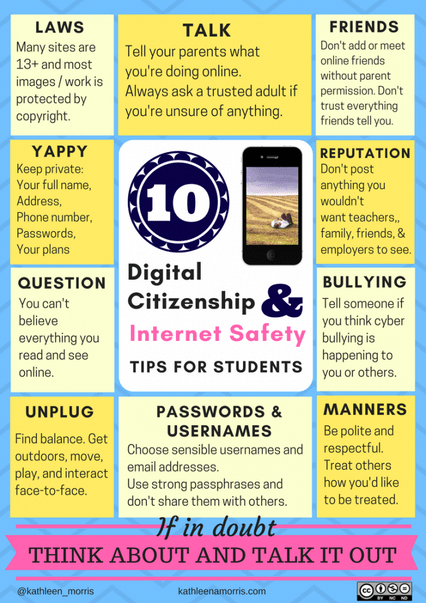Offer Practical Strategies
Apart from teaching children what we should not do, we need to equip them with practical strategies about what to do instead.

For example:
- We don’t want students accessing inappropriate content, so we need to teach them what to do if they come across a website that doesn’t look safe or appropriate (eg. closing tabs, telling adults, not clicking on random links etc).
- We don’t want students to leave a negative digital tattoo/footprint, so we need to teach them about creating a positive online presence. Having no footprint/tattoo at all probably isn’t the answer.
- We don’t want students creating short passwords with identifiable information, so we need to help them understand what a strong passphrase is.
- We don’t want students sharing their YAPPY information online, so we need to help them generate ideas of safer information to share with others in their online communications.
- You can’t use any image off Google to illustrate your digital work, so students need an understand about using Creative Commons.
Bullying – No Way!
Bullying online (sometimes called cyberbullying) is using technology to deliberately and repeatedly bully someone else. It can happen to anyone, anytime, and can leave you feeling unsafe and alone.
Bullying online can include:
- abusive texts and emails
- posting unkind messages or images
- imitating others online
- excluding others online
- inappropriate image tagging
Bullying online can be offensive and upsetting and you don’t have to put up with it.
If you are being bullied, stay CALM and THINK clearly
- Do not respond to the message when they or you angry or upset.
- Encourage them to tell someone: a parent or carer, relative, adult friend or teacher.
- Ask your teacher if your school has a policy in place to deal with bullying if it happens online.
- You can speak to someone online at Kids Helpline http://www.kidshelp.com.au/ or call them (free) on 1800 55 1800.
Protect your children’s phone
- Tell them to give their phone number to friends only.
- Keep their mobile phone away from those who shouldn’t have their phone.
- Use ID blocking on the phone to hide their number when they call others.
- Think about whether it is appropriate to send the message or make a call.
- Regularly check privacy settings on the mobile phone.
- For help using the privacy features on the phone, call your mobile company’s customer care number.
Protect yourself on social networking sites
- Regularly check and re-set the privacy settings on their social networking profiles.
- Most social networking profiles start with minimum privacy; make sure you select the settings you need to share your personal information only with those you want to.
- Don’t share any passwords, even with friends.
- Think about whether you would want other people to see their images; some images should not be posted in public places.
Report it
- Keep records of calls or messages that are offensive or hurtful.
- Visit the Office of the eSafety Commissioner’s Report, Cyberbullying section: https://www.esafety.gov.au/complaints-and-reporting/offensive-and-illegalcontent-complaints/report-offensive-or-illegal-content for advice about reporting and direct links to social network and online gaming websites reporting pages.
- If you are physically threatened call the police in your state or territory.
- Report serious online bullying to https://www.esafety.gov.au/complaints-andreporting.
For more information visit https://bullyingnoway.gov.au/
Retrieved from https://bullyingnoway.gov.au/ on 26/6/18

You must be logged in to post a comment.